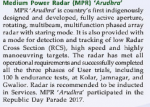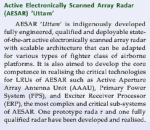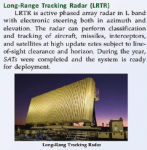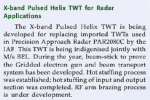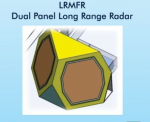HIGH POWER RADAR (HPR)
1. Description of Technology: The HPR is an Active Aperture Phased Array Radar based on Solid State Trans-Receive Modules. The Active Phased Array technology allows electronic scanning in azimuth as well as elevation. These radars have non-rotating design with planar arrays and provide 3600 coverage without the requirement of mechanical rotation. There is seamless transition of tracks from one planar array to another planar array. The HPR is able to detect targets of 2m2 RCS at a distance of 450 Km. The radar is to classify targets automatically and it has ECCM features.It is able to resolve target in four dimensions (4D) namely Range, Azimuth, Height and Doppler Velocity. The radar is equipped with ICAO & STANAG 4193 compliant IFF system with provision to operate independent of primary radar.
2. Installation and Maintenance aspect The Radar will be installed and integrated at the deployment site. It is capable of being sited up to an altitude of 3000m Above Mean Sea Level. It can withstand severe environment conditions.The HPR would be able to operate on a 24x7 basis with low maintenance requirements and will be integrated in the IACCS Network of IAF.
3. Performance evaluation The Field trials of the radar in integrated mode will be carried out at deployed location, to meet each parameters of the Radar Specification.
4. Realization Approach The design of radar is based on proven technology available with LRDE. 5 HPR – Four Wall Physical Configuration The illustrative picture of static four-wall physical configuration of HPR is shown as below
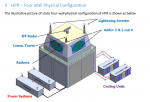

1. Description of Technology: The HPR is an Active Aperture Phased Array Radar based on Solid State Trans-Receive Modules. The Active Phased Array technology allows electronic scanning in azimuth as well as elevation. These radars have non-rotating design with planar arrays and provide 3600 coverage without the requirement of mechanical rotation. There is seamless transition of tracks from one planar array to another planar array. The HPR is able to detect targets of 2m2 RCS at a distance of 450 Km. The radar is to classify targets automatically and it has ECCM features.It is able to resolve target in four dimensions (4D) namely Range, Azimuth, Height and Doppler Velocity. The radar is equipped with ICAO & STANAG 4193 compliant IFF system with provision to operate independent of primary radar.
2. Installation and Maintenance aspect The Radar will be installed and integrated at the deployment site. It is capable of being sited up to an altitude of 3000m Above Mean Sea Level. It can withstand severe environment conditions.The HPR would be able to operate on a 24x7 basis with low maintenance requirements and will be integrated in the IACCS Network of IAF.
3. Performance evaluation The Field trials of the radar in integrated mode will be carried out at deployed location, to meet each parameters of the Radar Specification.
4. Realization Approach The design of radar is based on proven technology available with LRDE. 5 HPR – Four Wall Physical Configuration The illustrative picture of static four-wall physical configuration of HPR is shown as below





